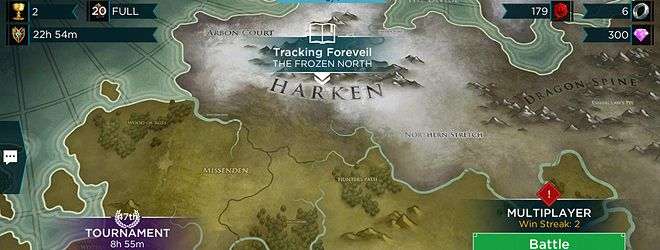Rival Kingdoms: Age of Ruin – Review
by Mark R
|
 Before smartphones and tablets existed, those who had a desire to retain productivity on the go had the choice of either the traditional bulky laptop or, if you wanted something a little more discreet and portable, a pocket PC. In 2003, I had one such device – the O2 XDA II – and it was great for email, accessing the web, and the occasional round of Minesweeper, but trying to get a decent game to run on it was a veritable nightmare. With my love for the strategy genre, I ploughed through forum after forum, performing random installations in the hope that I’d one day get Command & Conquer or UFO: Enemy Unknown to work on it.
Before smartphones and tablets existed, those who had a desire to retain productivity on the go had the choice of either the traditional bulky laptop or, if you wanted something a little more discreet and portable, a pocket PC. In 2003, I had one such device – the O2 XDA II – and it was great for email, accessing the web, and the occasional round of Minesweeper, but trying to get a decent game to run on it was a veritable nightmare. With my love for the strategy genre, I ploughed through forum after forum, performing random installations in the hope that I’d one day get Command & Conquer or UFO: Enemy Unknown to work on it.
Eventually, after some serious messing around and installing a few crudely manufactured emulators, I was able to play UFO: Enemy Unknown during one of my long train journeys between London and Glasgow. It ran windowed and was so unresponsive that it was practically unplayable, but I’d still managed to achieve what I’d set out to do, and that was to bring strategy games to a portable device. In my mind, the strategy genre was perfect for this technological advancement because the touch-screen functionality made it much quicker to operate than a combination of mouse and keyboard. All I could think of was “why the hell haven’t the strategy developers embraced this tech?”.
Thankfully, London-based developers Space Ape must have heard my tormented cries as I pulled away from Euston so many times, because their latest release more than proves my point about how perfect the marriage of touch-screen and strategy could possibly be. The fact that Rival Kingdoms: Age of Ruin hit the virtual shelves during this current generation of tablet means that it’s not only faster and more responsive that it would have been several years ago, but the graphics are pretty damned stunning. This is further reinforced when you pinch and zoom in to admire the level of detail that’s gone into the aesthetics.
 Rival Kingdoms is a fantasy-themed real-time strategy, complete with the typical tiered base building that you’ve come to expect from the genre. It is, in essence, an MMO. Don’t let that put the antisocial types off, however, because there is absolutely nothing to force you down that route and you can easily do as I did and spend your time going through the story mode and jumping into what they’ve called ‘multiplayer’ but which is, in fact, still a solo mission as you don’t actually come face to face with another player.
Rival Kingdoms is a fantasy-themed real-time strategy, complete with the typical tiered base building that you’ve come to expect from the genre. It is, in essence, an MMO. Don’t let that put the antisocial types off, however, because there is absolutely nothing to force you down that route and you can easily do as I did and spend your time going through the story mode and jumping into what they’ve called ‘multiplayer’ but which is, in fact, still a solo mission as you don’t actually come face to face with another player.
The multiplayer aspect comes from the fact that you are attacking the actual base of a legitimate player, but it’s done almost in ‘afk’ mode where they can’t retaliate in realtime, and are relying solely on how well they’ve constructed their own base defences. Whenever you wage war against any of the players, you are shown how much of their loot will be available to you as the victor – this will contain a percentage of their gold storage, as well as a portion of however many rings or other artefacts they have in their inventory at the moment they were randomly selected to be your opponent.
 |
 |
 |
 |
 |
 |
Once you’ve been introduced to the rival’s base, it’s very easy to run in with a gung-ho attitude and throw everything you have at them, but it will likely result in defeat. It may be an asset, although it may also to its detriment, but there’s no way to actually control your troops once you’ve selected which ones to send where. They will initially target whichever structure is highlighted when you place them, but if they survive this particular command they will continue on through the base taking down each subsequent building as they near it. Initially, I was concerned that I couldn’t change their direction and send them to help other units but, after countless hours in battle, it’s never actually impacted the combat too much. This is perhaps aided by the fact that you’re never playing against another real-world player as their base is essentially devoid of any infantry when you attack.
 While this may instill a degree of complacency among players, knowing that they’ll never have to go head-to-head against another army and make split-second decisions, it’s important to understand that you too are one of the randomly selected conquests. I discovered this, much to my chagrin, after returning from a winning streak of twelve battles, only to find that a good portion of gold from my home base had vanished. It was then that I spotted the notification informing me that I’d been attacked three times while I was busy laughing at how much gold I was stealing from others.
While this may instill a degree of complacency among players, knowing that they’ll never have to go head-to-head against another army and make split-second decisions, it’s important to understand that you too are one of the randomly selected conquests. I discovered this, much to my chagrin, after returning from a winning streak of twelve battles, only to find that a good portion of gold from my home base had vanished. It was then that I spotted the notification informing me that I’d been attacked three times while I was busy laughing at how much gold I was stealing from others.
Fear not, however, as there are many ways to defend your base as long as you have the resources to do so. Structures are built using gold that you’ve either mined from the area around your base, or that you’ve plundered from others. As with all strategy games, there’s a waiting period before the structure becomes available and this is where the potential for in-app purchases comes in to play. For many of the buildings, there’s an option to skip the build time for free, but the more advanced will require a trade-off of diamonds in exchange for the insta-build option.
Although it’s entirely possible to collect diamonds along the way from winning battles and completing in-game challenges, the rate at which they’re dispensed will never run in parallel with the number you’ll need to maintain a suitable level of progression. Once you reach this stalemate you have a decision to make – whether you shut down your tablet for the night and let the twelve-hour waiting period run its course, or jump through to the in-game store and buy a bundle of gems to speed up the build process.
 It’s a clear testament to Space Ape that my first instinct was to stump up some cash and throw diamonds at my base so I could build enough new structures and upgrade existing facilities to make it easier to defend myself against attackers, and to take more units with me on my own plundering adventures. Admittedly, it made a huge difference to the gameplay as I was able to maintain a high level of immersion and continue to fight my way through the first stage of the story mission, ending in a boss battle with a dragon who, upon defeat, offered their services and became part of my home base.
It’s a clear testament to Space Ape that my first instinct was to stump up some cash and throw diamonds at my base so I could build enough new structures and upgrade existing facilities to make it easier to defend myself against attackers, and to take more units with me on my own plundering adventures. Admittedly, it made a huge difference to the gameplay as I was able to maintain a high level of immersion and continue to fight my way through the first stage of the story mission, ending in a boss battle with a dragon who, upon defeat, offered their services and became part of my home base.
In addition to regular base defence structures and a growing infantry, there are also Ancients available to help you on your way. During a base attack you will pick up mana as the enemy base is destroyed and, as the mana builds up, your elemental attacks will unlock. What you have in your arsenal depends entirely on which Ancient you have selected to guard your base, and their ability relies heavily on how much you’ve upgraded them. The more rare the Ancient, the greater their power is from the outset, and their attack types vary based on their origin.
Beyond the single-player story mission and pseudo-multiplayer battles, we have Kingdoms. You can either join an existing Kingdom – some are open to anyone while others require a join request to be sent – or start your own. In the interest of exploration, I created my own but it wasn’t ever made very clear to me how the kingdoms actually worked, how best to maintain them, or what their purpose was. From what I could gleam, it would appear that it’s a glorified clan, and this would make sense as it’s also possible to enter tournaments and chat with other players in realtime to coordinate attacks. For the solo player, however, there’s more than enough to keep you going.
After the initial buzz of being able to soldier through the base-building process, and recruiting additional units and unit types, it was far too easy to consider spending out more real-world cash on another stash of diamonds to keep the momentum going. Rival Kingdoms is, quite honestly, that good. The combination of a lore-heavy story written by Rhianna Pratchett, stunning detailed graphics, a rousing soundtrack, and a cleverly structured combat system makes for an incredibly satisfying game. When you consider that you’re also playing it on a tablet, it further amplifies what Space Ape have achieved by bringing such an in-depth and beautifully tactile game to the mobile world. It’s been a long-time coming, but I now have a great strategy game to keep me company on long journeys; now I just have to wait for a tablet with a battery life to justify how immersive it is.
Pros- It's free to play, if you don't use the in-app purchases
- Beautifully detailed graphics
- Your base has a sense of occupation to it, rather than remaining stagnant
- Despite the lack of control after initial deployment, the combat works well
- Great range of units and Ancients, as well as defensive structures
- The story, while sparsely delivered, is interesting enough to keep you hooked
- Review option to let you watch your last battle play out in full
- The in-app purchases can go as high as £79.99, which is more than many triple-A special editions
- Not much of an explanation as to how kingdoms work
- The build times can be longer than a full day in real terms, which can be frustrating if you're immersed in its progress
For a free-to-play game on a mobile device, there's a surprising amount of gameplay extended to you before it gets to the point where you need to consider topping up cash or diamonds with in-app purchases. Compared to the twenty or so minutes from Theme Park Android before it wanted your first-born's soul, I would wager that I managed to pull a solid three-to-four hours from Rival Kingdoms before the temptation to part with real-world cash became a consideration. That, to me, speaks volumes about how much Space Ape want their customers to genuinely enjoy the game. Visually, it's stunning, and that helps a lot. Even the limited control over combat situations doesn't detract from how enjoyable the game is overall. If you can shake off that typical 'keep going' attitude and actually shut your tablet down overnight to let structures build, then Rival Kingdoms has the potential to be at the top of the mobile strategy genre. If you're impatient, however, make sure your credit card is nowhere near its limit.
Last five articles by Mark R
- From Acorns to Fish
- Alone In The Dark
- Why Borderlands is Better Than Borderlands 2
- Falling Short
- The Division: A Guide to Surviving the Dark Zone Solo
























There are no comments, yet.
Why don’t you be the first? Come on, you know you want to!